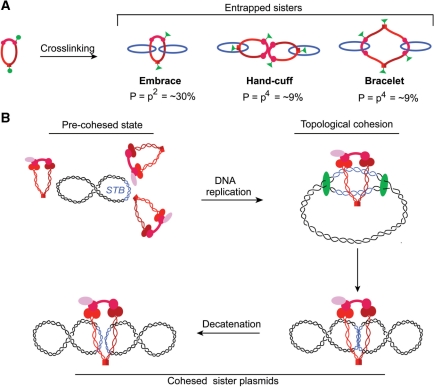Figure 6.
A single ring formed by a monomeric cohesin complex as the unit of cohesion at STB. (A) The results from Haering et al. (18) for CEN cohesion ruling out ‘double’ rings of cohesin are schematically represented. In their experimental design, covalent protein ring closure required crosslinking two neighboring pairs of cysteines at two locations (green circles) to form a pair of chemical bridges (green triangles). Cross-linking efficiency (or probability ‘p’ of circle to triangle conversion) was ∼55% in their assays. Experiments agreed with entrapment probability of DNA sisters ‘P’ equal to p2 (30%) and not p4 (9%). Note that, upon SDS treatment during the assay, a physical hand-cuff (but not a topological one) would fall apart to yield monomeric cohesin rings, each with a single trapped plasmid molecule. (B) In the pre-cohesed state of the 2 micron circle, multiple cohesin molecules may interact physically and dynamically at or near STB. Such interactions could be promoted by the cohesin loading factors Scc2 and Scc4, which are required for cohesin assembly on the plasmid (5). Transition to the stable topological association may be mediated by passage of the replisome and closure of a single cohesin ring around a pair of STB sisters.

